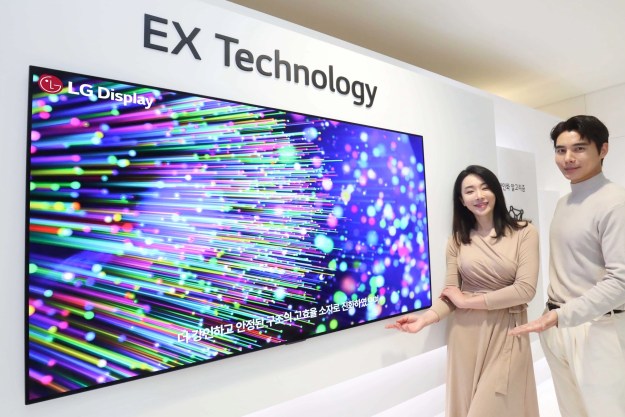“The LT30 is a very good first effort, and we look forward to seeing more products from this company.”
- Separate memory for video settings on each input; good picture quality for the price
- Weak bass; lackluster remote control; confusing labeling on inputs/outputs
In May 2004, Syntax Group Corporation announced its entry into the LCD TV market with its Olevia brand of 27″ and 30″ models. Since then, Olevia has been one of the fastest-growing LCD TV brands in North America.
Syntax’s Entertainment line introduces the 30″ digital wide screen LCD TV. Displaying WXGA resolution (16:9 wide-screen format) with a 750:1 contrast ratio and 170 degree wide viewing angles, the Syntax TV is equipped with all the bells and whistles.
We decided to take a look at the LT30 30″ model to see what’s behind this rapid growth.
Design and Features
Weighing in at 50 pounds with its built-in stand, the LT30 is relatively easy for one person to remove from its shipping material and place on a table.
The TV and side speakers are silver plastic, and there is a metal trim panel between the LCD and the bottom of the TV. Overall, it’s attractive and has a nice profile with the rear cable covers in place.
There are three dress covers on the back of the panel that cover the various inputs and outputs. The DVI / HDCP and RGB inputs are recessed behind cover “A.”
The AV ports, consisting of the S-Video In, Composite In (CVBS), Audio R/L in, audio R/L out, headphone out, subwoofer out, and Component In (YPbPr) for progressive scan and (YCbCr) for interlaced scan, are recessed behind cover “B.”
A neat cable management system is behind cover “C,” above the pedestal, as well as the TV RF terminal for the dual NTSC tuners.
Syntax’s LT30HV looks very stylish
Setup and Use

The only drawback to the neat connector arrangement is that the connectors cannot be viewed straight on when connecting the cables. This is due to the connectors being recessed in the “A” and “B” compartments and mounted parallel to the back of the panel. This design keeps the cables from protruding straight out of the back and enables the smooth panel profile. Connection diagrams are provided in the “A” and “B” compartments.
The headphone output is placed in the “B” compartment, but is accessible with the cover in place. A better location would have been on the bottom of the panel, where the panel controls are placed.
A Toshiba SD-6915 DVD changer with progressive scan output was connected to the YPbPr component input on the LT30. A Dish Network PVR was connected to the S-Video input. According to the manual, there is a second component input labeled YCbCr for interlaced input. In spite of it being labeled differently than the progressive scan input (YCbCr is the nomenclature for digital component input), we suspect that both are analog component inputs. The bottom line is that there are two component inputs, but only one is designated for progressive scan inputs.
Picture
The LT30 video was quite good, as its specifications would suggest. There was some observable motion delay with some of the satellite programming, but this was not visible with the DVD player on the component input.
The LT30 displayed nice, bright colors, with only a slight hint of too much red on some video sources. Skin tones were natural and mostly accurate between different video sources. Contrast was very good for an LCD TV and the blacks were reasonably accurate.
The display has three backlight brightness settings: Bright, Normal, and soft. Each was very usable under various room lighting conditions. The “Bright” backlight mode provided a very good display quality in a well-lit room. This particular unit exhibited an audible buzzing from the power supply when the “Normal” or “Soft” brightness settings were selected. There was no buzzing when “Bright” was selected. The buzzing sound was usually masked by the audio, but could be annoying at low listening levels. Fortunately, the buzzing was confined to the power supply and did not intrude on the audio circuitry of the LT30.
Viewing angles were very good. There was no noticeable variation in brightness with horizontal position, even at extreme angles. The vertical viewing angle exhibited a very slight variation in brightness with position, but was only noticeable when we were looking for it critically: very good overall.
With a PC connected to the VGA input, the LT30 provided good video quality. The image was very sharp and the colors appeared quite natural. The split screen function was tested with the VGA input and the satellite input. The function worked well and the VGA auto-sizing feature could be seen accurately placing the VGA display. If this mode is used frequently, the display will obviously need to be placed more closely than when viewing full screen sources. A deep desk or separate working surfaces will be needed, as sitting across the room and viewing a computer display on one half of a 30″ display will be difficult.

The LT30HV in Split Screen Mode
The screen aspect setting includes 4:3 or full screen (16:9), selectable from the on-screen menu, but it is not selectable from the remote. A zoom function will expand a 4:3 image to fill the screen. The zoom factor is not adjustable and there is no zoom in 16:9 mode.
There is a separate setup memory for each video input. This was very useful, since the preferred settings for the DVD player and satellite box were different.
|
PICTURE SETTING USED |
||
|
SETTING |
SATELLITE TV |
DVD |
|
INPUT |
S-VIDEO |
YPbPr (PROGRESSIVE) |
|
Brightness |
47 |
54 |
|
Contrast |
52 |
48 |
|
Backlight |
Bright |
Bright |
|
Color Temperature |
Normal |
Normal |
|
Tint |
50 |
50 |
|
Saturation |
40 |
47 |
|
Red Gain |
50 |
50 |
|
Green Gain |
50 |
50 |
|
Blue Gain |
50 |
50 |
|
Sharpness |
67 / 50 Digital PGM / Analog (Local Stations) |
0 |
|
Noise |
Low |
Low |
|
Treble |
Minus 2 |
Minus 2 |
|
Bass |
Plus 12 |
Plus 12 |
|
Balance |
0 |
0 |
Sound
The LT30 comes with two side mount panel speakers that can be removed. We found the bass response of these speakers to be very weak. The treble control was set at “Minus 2” and the bass was set at “Plus 12” in an attempt to compensate. The speaker wires were checked for proper phase, but this did not correct the bass deficit.

There is a line-level subwoofer output on the back of the panel. If the display is used often with the built-in audio, we suggest connecting one of your “spare” PC subwoofers to this output.
Remote and Controls
The front panel controls on the LT30 are placed beneath the panel, where they are not obtrusive. The labels are clear, so the controls are quite convenient (except for that headphone jack.)
In addition to Power, Volume, and Channel, there is a Menu button and a Source button. We applaud manufacturers who provide access to the full menu of features with or without using the remote control. The LT30 proves that it can be done without being obtrusive to the design.
The LT30’s remote control is uncluttered and the Volume, Channel, Channel Return, Menu, and Power buttons are well-placed. Unfortunately, that is the only good news. The Mute and MTS buttons should be swapped to put the Mute button within easy range of the volume control. The MTS button, which is used much less frequently, should be placed at the top of the remote.
The Source button is well-positioned beneath the Vol/CH cluster; however, once a source is selected, the “Enter” button, which is poorly placed below “9” on the numeric keypad, must be pressed to accept the selected source.
The PIP controls and other less frequently used functions are hidden behind a sliding door at the bottom of the remote.
On-Screen Display (OSD)
When the menu button is depressed, an on-screen display box is overlaid on the video in the middle of the display. The main menu categories, Picture, Audio, Setup, and Screen, are displayed across the top of the box.
The OSD menu options are easy to adjust. Our only complaint is the fixed size of the menu box, which can be difficult to read from a distance. It would be more helpful if each menu item were magnified as the cursor is moved over the items. We understand there is a tradeoff between the size of the menu and ability to see the adjustment results on the picture behind the menu box overlay; however, there are better ways to address this conflict.
When selecting an input source, the inputs displayed on the screen are the same as the labels on the back of the panel. There is no facility for re-labeling the input names. For example, the DVD input was “YPbPr,” not “DVD,” and the Satellite input is “S-Video,” not “SAT.” “YPbPr” may be accurate, but it’s not intuitive when selecting the DVD.
Conclusion
Syntax/Olevia has entered the LCD TV market with a product line that is very compelling for its performance and price. The LT30 is a very good first effort, and we look forward to seeing more products from this company.
If you are looking for a reasonably-priced 30″ LCD TV with pleasant styling, good performance, and a rich feature set, the LT30 should definitely be considered.
Pros
- Separate memory for video settings on each input
- Very good picture brightness and detail
- Good contrast and viewing angle
- Warranty: On-site one year
Cons
- Remote control design, button placement
- Weak bass from built in speakers
- Buzzing sound when backlight is in “normal” position
- Input source labels cannot be customized – confusing labeling
Editors' Recommendations
- ESPN’s standalone subscription could hit $30, receive preference on Roku
- Updating our Sony WF-1000XM5 review
- Samsung S95C OLED hands-on review: it’s time to get excited
- All the new tech that blew our reviewers away this month
- Shocker: Amazon reviews still can’t be trusted




